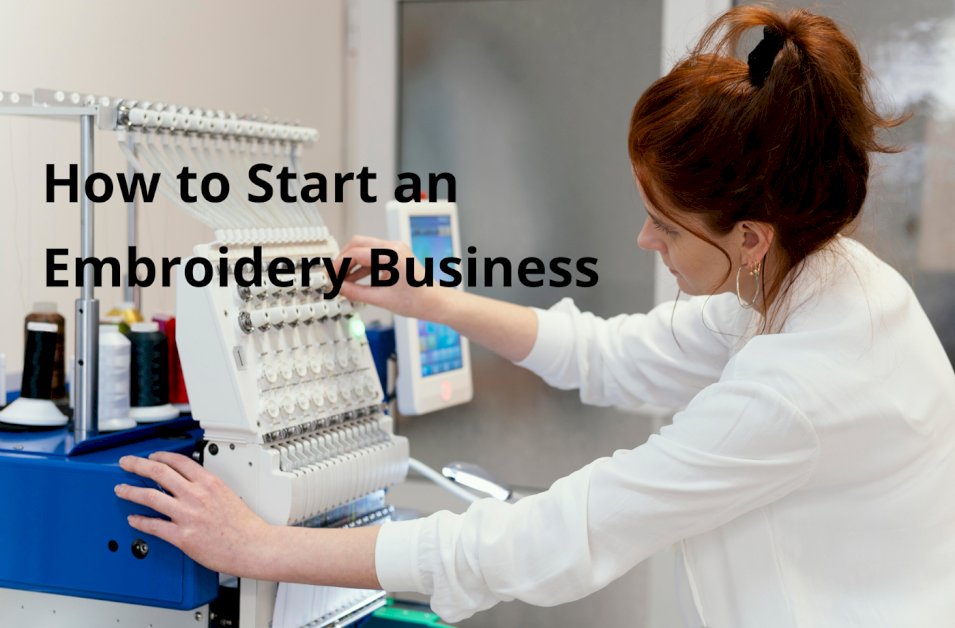This business model offers flexibility, and demand for custom embroidery keeps growing—from personalized gifts to branded uniforms. Whether you’re monogramming towels or stitching your logo onto polo shirts, there’s a strong market for high-quality, customized work.
This guide walks you through the essential steps to launch a successful embroidery business, covering how to find your niche, select products, and market your brand effectively.
1. Find your niche
Finding your niche isn’t just the first step—it’s the foundation of a profitable embroidery business. Get it right, and you’ll attract the right customers, boost profits, and build a brand you love.
Here are potential niches for your embroidery business:
Product-based: Baby clothes and gifts, branded workwear/uniforms, bags, luxury towels and sheets, custom hats, patches, home decor.
Audience-based: New parents, school/sports teams, wedding parties, pet lovers, specific groups (e.g., golfers, truckers), corporate gifts.
Style-based: Monograms, graphic patches, vintage designs, minimalist looks, or humorous logos.
Pro Tip: Your ideal niche combines passion and profitability while leveraging your unique skills. Ask yourself: Who do I love creating for? Which products inspire me most?
2. Choose your products
Choosing which products to offer is a crucial step—it should align with your niche and customer preferences. Common embroidery products include:
- T-shirts and hoodies
- Tote bags and backpacks
- Towels
- Hats and caps
- Pillowcases and patches
Consider starting with a limited product line to maintain quality and simplify operations. Over time, you can expand your offerings based on market demand and customer feedback.
3. Invest in an embroidery machine
Embroidery machines are the backbone of your business. Investing in a reliable, high-quality machine ensures consistent, professional results. When choosing a machine, consider the following factors:
New vs. Refurbished/Used machines:
A new machine comes with a warranty and the latest features but requires a larger upfront investment. Reputable dealers often offer inspected and repaired refurbished or used commercial machines, which can be a cost-effective alternative.
Number of needles (Heads):
This determines how many colors you can embroider without manually changing threads. Common options include 4, 6, 8, 12, or more heads.
Embroidery field size:
The maximum design size (width × height) the machine can stitch determines the logo and design sizes you can offer.
Speed:
The machine’s operating speed affects production volume.
Software compatibility:
Make sure the machine works smoothly with your chosen embroidery software. Most modern machines support common file formats like .dst or .emb.
Additional costs to consider:
Factor in expenses beyond the machine itself—digitizing software, hoops and accessories (for hats, sleeves, etc.), thread, needles, stabilizers, maintenance contracts, and potential electrical upgrades. Many embroidery machines include basic accessories, but specialized software for complex designs may require an additional purchase.
4. Create your embroidery designs
Design is a key factor in attracting potential buyers, so crafting your designs carefully is essential. This step will take up most of your time and requires specialized skills.
Find inspiration: What themes appeal to you? Nature, pop culture, humor, quotes, abstract patterns, pets, or flowers? Explore trends (without blindly following them) and observe local preferences to spark ideas. You can also use AI tools for inspiration, but ensure the designs fit your niche.
Digital embroidery software: This is necessary to turn your ideas into machine-readable stitch files. Popular choices include Wilcom and Hatch Embroidery. Invest time in learning your software—it’s your most critical tool. Begin with the basics and slowly build your digitizing expertise.
Consider outsourcing: If digitizing feels overwhelming at first, or your design is highly complex, you can hire a professional digitizer. Look for freelancers on Fiverr.com. Confirm they meet your quality standards and provide files in your machine’s required format (PES, DST, JEF, EMB, etc.). Be sure to include this cost in your pricing.
5. Test your designs
Before investing heavily in inventory or officially launching your designs, rigorously testing your embroidery patterns is essential. This isn’t just about verifying the file works—it’s about ensuring your design is high-quality, durable, and meets real-world customer expectations.
Don’t just preview your designs digitally! Stitch them on an actual embroidery machine and test them on the fabrics you plan to use (e.g., cotton tees, polyester hats, canvas bags, denim, etc.). Different materials require adjustments for stitch density, tension, backing, and stabilization.
Focus on these key areas:
Stitch quality: Look for broken threads, skipped stitches, or loose ends.
Tension & fabric distortion: Does the fabric pucker, stretch, or warp? Does the design lay flat?
Color accuracy: Do the thread colors match expectations? How do they look on different background colors?
Detail clarity: Are small text, fine lines, and intricate elements sharp and readable? Are edges clean?
Size & placement: Is the design proportioned correctly and positioned well (e.g., centered on a tee, aligned on a hat)?
Get honest opinions: Share test samples with friends, family, or potential buyers for feedback.
6. Sell them in your store

Once you’ve completed these steps, it’s time to find a new, appreciative home for your pieces! Setting up an effective sales channel is key—and for most, that means launching an online store.
Choose your sales platform
Online marketplaces (Etsy, Shopify, etc.): This is the most popular and often most budget-friendly way to start. Platforms like Etsy bring in built-in traffic (especially for handmade items), while Shopify allows for more brand customization. When deciding, consider fees, ease of use, your target audience, and the features you need.
Create an appealing storefront
High-quality product photos: Use bright, crisp images that showcase your work from different angles—close-ups of details, the embroidery displayed on a wall, the bag being worn, and sizing references. Stick to a clean, simple background to keep the focus on the product.
Compelling descriptions: Share the inspiration behind the design, its significance, material details (fabric, thread type), exact measurements, and the craftsmanship involved.
Transparent pricing: Make sure your prices account for all costs (materials, labor, platform fees, packaging, and marketing) while including a fair profit. Avoid surprises by being upfront about pricing.
Smooth checkout process: Keep purchasing simple with multiple secure payment options, and clearly display shipping costs and delivery times.
7. Promote your embroidery business
Once your embroidery business is up and running, effective promotion is essential for attracting customers and growing your brand. Here are some strategies to help you market your work:
Social media marketing: Highlight your creations on platforms like Instagram, Facebook, and Pinterest. Share high-quality photos, behind-the-scenes videos, and customer reviews.
Website & SEO: Build a simple website or online portfolio to display your services. Use relevant keywords in your niche to boost search engine rankings.
Related article: The Beginner’s Guide to Etsy SEO
Referral program: Reward happy customers for referring friends with discounts or freebies.
Email marketing: Gather email addresses and send newsletters featuring new designs, promotions, or seasonal deals.
Partnerships: Collaborate with influencers, bloggers, or other small businesses to reach a wider audience.
Paid advertising: Consider testing Meta Ads and Google Ads. Don’t depend on just one paid channel—algorithm shifts can be unpredictable.
Start your embroidery business with JetPrint
Struggling with equipment costs or finding reliable suppliers? These challenges are preventing you from capitalizing on the booming demand for custom apparel, bags, and gifts.
With JetPrint, you can seize these opportunities today—no more letting production bottlenecks limit your growth. Our print on demand embroidery solutions let you launch your embroidery business without inventory or expensive machines. You can:
Quick design: Skip the steep learning curve. Just upload your favorite images, set up in minutes, and start accepting orders—no complex software or lengthy training needed.
Automated order processing: Effortlessly handle orders and offer worldwide shipping to your customers.
Easy scalability: JetPrint’s vast product range lets you expand your offerings seamlessly, so you’re always ready for urgent opportunities.
Don’t let equipment or product limitations cost you sales. Hundreds of successful embroidery businesses rely on JetPrint for speed, quality, and reliability—helping them create urgency for customers and close deals faster.
Conclusion
You’ve just completed major steps in launching your embroidery business—from planning and buying equipment to selling your embroidered products. It’s a journey that blends creativity with patience, turning passion into profit.
Whether you handle equipment and materials yourself or rely on JetPrint for manufacturing and shipping, always prioritize product quality and customer satisfaction. This builds lasting relationships, strengthens your reputation, and ensures your embroidery business thrives.
FAQ
How much does it cost to start an embroidery business?
Startup costs vary widely depending on the scale.
Basic option (Part-time at home):
- Very low cost ($1,000–$3,000): Covers a reliable home or small commercial embroidery machine, basic supplies (thread, needles, stabilizer, a small stock of blanks), and entry-level software/designs. You can often start in your existing home space.
Small studio ($5,000–$15,000): Includes one or more professional single- or multi-head embroidery machines, a basic inventory, minor workspace renovations, business registration, insurance, and marketing materials.
Can I start an embroidery business from home? What are some things to keep in mind?
Absolutely! Many entrepreneurs begin this way.
Key considerations:
-
Space: Ensure enough room for the machine, supplies, finished products, and packaging.
-
Noise: Be mindful of family/neighbors—you may need to limit operating hours or add soundproofing.
-
Electricity: Check if your home’s electrical circuit can handle the machine’s load.
-
Work-life balance: Set clear boundaries to keep work from overtaking personal time.
How do I price my embroidery services?
How long does it take to complete an embroidery project?
Factor in these costs:
- Supplies: Blanks, thread, stabilizer, and other materials.
- Machine costs: Depreciation or leasing fees.
- Labor: Your time for designing, setup, production, communication, and management.
- Overhead: Electricity, rent, software, marketing, insurance, and maintenance.
Common pricing models:
- Per-project pricing: Quote based on complexity and time (ideal for custom designs).
Additional considerations:
- Design complexity: More colors, stitch density, or size increases cost.
- Order volume: Bulk orders often qualify for discounts.
- Market rates: Research competitors’ pricing.
- Value add: Superior quality, speed, or service may justify higher prices.




